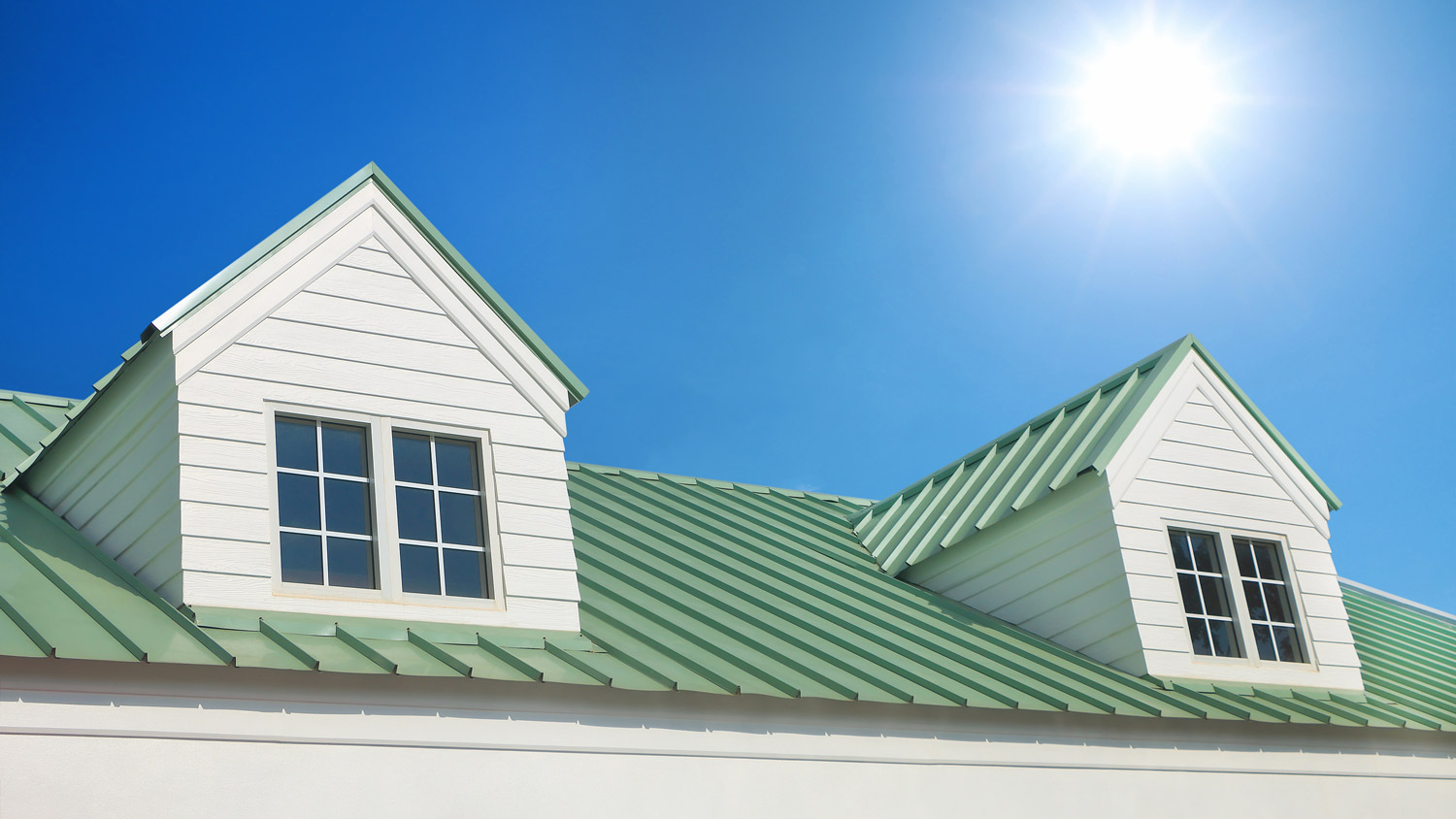Do Metal Roofs Make Your House Hotter?
Raise the roof, not your indoor temperature


Metal roofs are some of the best roofing options for hot climates because they reflect heat and help avoid solar heat gain.
A light-colored metal roof is best at keeping indoor temperatures cool, as it will reflect more light than a darker color.
Adding insulation under your metal roof can maximize home energy efficiency and help maintain comfortable indoor temperatures year-round.
Metal roofs are a popular option in cold climates because they shed snow easily and are suitable for steeper roof pitches than asphalt shingles. But what about hot climates? Do metal roofs make your house hotter? In this guide, we’ll discuss everything you need to know about how a metal roof affects your indoor temperature.
Will a Metal Roof Make Your House Hotter?
The short answer is no—a metal roof will not make your house hotter than asphalt shingles, clay tiles, or slate. In fact, metal is the most reflective roofing option, so it will actually keep your home cooler than most other roofing materials, especially in hot, sunny climates.
How Do Metal Roofs Help to Keep Your Home Cool?

There are four key ways metal roofs keep your home cool in hot, sunny areas, and understanding these factors can help you install the right metal roof for your home.
Reflectivity
First and foremost, metal is naturally reflective and will reflect a good portion of the sunlight that hits it away from your home. This helps reduce solar heat gain, which means the heat from the sun will stay outside rather than transfer through your roof.
High Thermal Conductivity
Metal also has a high thermal conductivity, which means it gains and loses heat rapidly. When the sun warms your metal roof, it will quickly heat up, but it will also lose heat readily to the air surrounding it. Since the heat is lost to the surrounding air, less of that heat transfers through your roofing system and into your home.
Cool Roof Options
Metal roofs come in a variety of colors, and lighter colors like red and white are considered “cool roof” options. Light colors naturally reflect more sunlight, so roofing materials like asphalt shingles and slate shingles that are almost always black or dark gray aren’t ideal for keeping your home cool. The fact that metal roofs are available in white means you can maximize reflectivity and reduce your cooling bills in hotter climates.
Insulation
Finally, it’s relatively simple to insulate under a metal roof. Most local metal roof installers will be able to couple your metal roof with rigid foam board insulation or even a reflective insulation to help keep the heat outside. Adding insulation will drive up metal roof installation costs, but it can be a worthwhile addition for boosting energy efficiency and saving on cooling costs over time.
"Metal roofing is great for snow prone homes because metal conducts heat really well, meaning it can warm up faster and melt the snow on top of it more quickly."
— Korey Gregory - Construction Supervisor at ASAP Restoration LLC
How to Keep Your Home Cool With a Metal Roof
Any metal roof will help keep your home cooler than asphalt shingles, but if you’re hiring a roofer to install a new metal roof, there are a few things you can prioritize to maximize your home’s energy efficiency.
Choose a light-colored roof: According to the Department of Energy, white and light-colored roofs reflect the most sunlight and keep your home the coolest. Choose a white metal roof for the best reflectivity.
Choose the right type of metal: The most common types of metal roofs are aluminum, stainless steel, zinc, and copper. Of these options, aluminum reflects the most thermal radiation, followed by zinc, steel, and copper. For the coolest home possible, choose an aluminum metal roof.
Add insulation: Paying a bit more for insulation under your metal roof can make a major difference when it comes to how your roofing material affects how hot your home gets. Choose a reflective insulation for the best results in sunny areas.
Frequently Asked Questions
Metal roofs boast a few advantages over more traditional asphalt roofs, the most impressive being a longer lifespan. Metal roofs last for up to 80 years, while asphalt roofs average between 20 and 30 years. Metal roofs are less likely to leak, depending on the type of metal roof you choose. They shed snow more easily and help keep your home cooler in hot, sunny climates.
There are two main issues with metal roofs: the up-front cost and how noisy they can be when it rains. Metal roofs cost close to twice as much as asphalt roofs per square foot, and although you also get more than double the lifespan and more value from them, the initial cost is higher. Metal roofs can also create noise in your living space when it rains, so some homeowners install acoustic panels or insulation under them to reduce noisiness.
A metal roof costs an average of $11,700 to install, or between $4 and $30 per square foot, depending on the type of metal roof and the metal material you choose. A standing seam metal roof is the most expensive option, and copper is the most expensive material, costing two to three times as much as aluminum, steel, and zinc.





- Roofers
- Metal Roofing
- Roof Repair
- Roof Inspection
- Vinyl Siding Repair Contractors
- Flat Roofing Companies
- Commercial Roofing
- Emergency Roofing Companies
- Leaky Roof Repair
- Metal Roof Repair
- Business Roof Repair
- Flat Roof Repair
- Tile Roof Repair
- Slate Roofers
- Rubber Roofers
- Roofing & Siding
- Metal Roof Installation
- Affordable Roofing
- Roof Sealing
- Attic Ventilation Contractors










